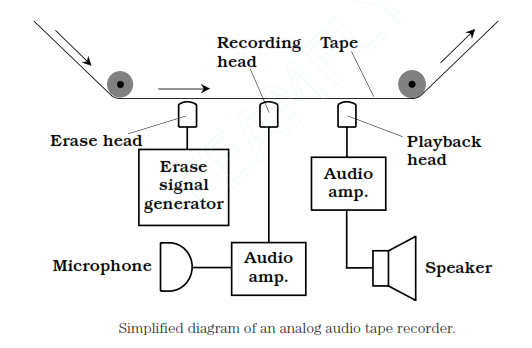Analog magnetic tape
Magnetic tape is unique in consumer audio because it conveniently allows consumers to record, as well as play back, hi-fi sound. (CD burners exist, but they are expensive compared to tape recorders.) Any form of private recording or reproduction can give rise to copyright infringement concerns. If you’re in doubt about the legality of making a tape recording of anything, consult a lawyer before you perform it.Tape recorders can be classified as either cassette or reel to reel. In the past several decades, cassette tape has replaced gradually reel to reel tape in consumer applications. Reel to reel tape is used still in some professional settings.
Magnetic tape cassettes come in several of sizes and shapes for the various applications. A typical audio cassette plays for 30 minutes on each side; longer-playing cassettes allow recording for as much as 60 minutes per side. The longer tapes are thinner and more subject to stretching than shorter tapes. Some cassettes, such as the kind used in stereo tape players, have endless loops of tape. Four recording paths, each having 2 channels for the left and the right half of the sound track, provide a total of 8 recording tracks.A reel to reel tape feed system resembles that of the old fashioned movie projector. The tape is wound on 2 flat spools called as supply reel and the take up reel. Thesupply reel is usually on the left, and the take up reel is on the right. The reels rotate counterclockwise as tape passes through recording mechanism. When take up reel is full and the supply reel is empty, both reels can be flipped over and interchanged. This allows recording or playback on the “other side” of the tape. (Actu- ally, the process takes place on the same side of the tape, but on different tracks.) A 7- inch-diameter reel can hold about 3000 ft of 0.5-mil-thick tape.
The speed is usually 1.875, 3.75, or 7.5 in per second (IPS). At slowest speed, the tape can run for several hours on each side.All tape recorders work in the same manner, acting as transducers between acoustic, digital, or video signals and variable magnetic fields. Figure given below is a simplified rendition of the recording/playback apparatus in a characteristic audio tape recorder. The same scheme is used in cassette machines and reel to reel machines.

Figure--Simplified diagram of an analog audio tape recorder.
In record mode, tape moves past the erase head before anything is recorded on it. If tape is not blank (i.e., if magnetic impulses already exist on it), the erase head removes these before anything else gets recorded. This prevents doubling, or simultaneous presence of 2 programs on the tape. The erase head can be disabled in some tape recorders when the doubling is wanted. This is at times done, for instance, in audio recording studios. The recording head is a miniature, precision electromagnet which generates a fluctuating magnetic field whose instantaneous flux density is proportional to instantaneous level of audio input signal. This magnetizes tape in a pattern which duplicates the waveform of signal. The playback head is not activated in the record mode. But, the playback head and circuits can be used while recording to create the echo effect.
In playback mode, the erase head and recording head are not activated. The playback head behaves as a sensitive magnetic-field detector, like a miniature low-frequency radio antenna. As the tape moves past this device, the playback head is exposed to the fluctuating magnetic field whose waveform is identical to which produced by the recording head when audio was originally recorded on tape. This magnetic field induces weak ac in the playback head. These currents are amplified and delivered to the speaker, headset, or another output device.